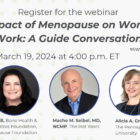Menopause is happening at work and no one is noticing
Women are half the US workforce, and half of those women are in perimenopause or menopause. That’s one fourth of the entire US workforce.
But menopause at work, neither women nor businesses isn’t getting the attention it deserves. That’s why in our book, Working Through Menopause: The Impact on Women, Businesses and The Bottom Line, we’re calling working through menopause a “silent ceiling.” Like the glass ceiling, first introduced by Marilyn Loden in 1978, menopause impacts both the quality of women’s lives and their ascent in the workplace.[i] All of this is occurring with little fanfare, recognition, or discussion.

New Book for Business Woman and Businesses
That has to change and the sooner the better. Women and businesses need information and support during this normal but impactful transition. It’s not only the right thing to do for women, it will also greatly benefit the bottom line of the businesses where they work.
The Harvard Business Review summarized the impact of menopause on women in the workplace very nicely:
Menopause often intersects with a critical career stage. It usually occurs between ages forty-five and fifty-five—which is also the age bracket during which women are most likely to move into top leadership positions. Since menopause generally lasts between seven and 14 years, millions of postmenopausal women are coming into management and top leadership roles while experiencing mild to severe symptoms such as depression, anxiety, sleep deprivation and cognitive impairment, to name a few. If we want to continue to move the needle on the number of women in leadership roles and maintain their valuable contributions to a company’s bottom line, we need to be more open about what menopause is and how it affects both individuals and organizations.[ii]
Menopause in the Workplace is Common
You may be thinking, “Hmm, interesting, but menopause is such a small niche.” If so, you’re thinking would be inaccurate. Roughly half the workforce in Canada, Australia, Sweden, the Netherlands and the UK is made up of women.[iii] Women make up at least forty percent (mean 45.4 percent) of the workforce in eighty countries.[iv] In the United States, the US Department of Labor reports that women are just over half the workforce.[v] Of those women, 20.1 percent are aged forty-five to fifty-four (15.5 million women), 17.3 percent are fifty-five to sixty-four (17 million women), and 8.1 percent are aged sixty-five and up (6.2 million). All together that is 45.5 percent of US women at work either in or approaching menopause. Another 21.1 percent of the female workforce is aged thirty-five to forty-four (16.4 million women) and as you will discover later in this book, a good number of those women will be experiencing menopause symptoms.
According to one UK study reported by Suban Abdulla in Yahoo Finance, “over half of working women aged forty to sixty-five have experienced three or more symptoms they know, or believe, are related to menopause, including hot flashes (forty-seven percent), night sweats (forty-one percent) and feeling tired (thirty-five percent). Half of all women experiencing three or more peri menopause or menopause symptoms have experienced at least one further detrimental impact on their working lives including, a negative impact on their relationships with colleagues, having to reduce their working hours, or considering resigning. Only twelve percent of the respondents said they have not experienced menopausal symptoms.”[vi] Thus, eighty-eight percent of that huge number of women are affected by the symptoms of menopause.
Businesses frequently offer programs for smoking cessation, pregnancy, pregnancy lactation, weight loss, insomnia, and others. These are important wellness programs. But none of those conditions happens to every woman. In contrast, menopause happens to every woman who lives long enough. Yet fewer than ten percent of UK businesses provide employees any information about menopause.[vii] The UK is much more progressive about menopause in the workplace than the United States where only about one percent of businesses provide any information about menopause to their employees. Menopause in the workplace is almost universally viewed as a taboo topic―something unspoken, and often treated as a joke.
Whether you’re a woman entrepreneur, a business woman or business that employs women, you and your business will benefit from know more occupational wellness information on this important topic. Click Here to get your copy of Working Through Menopause: The Impact on Women, Businesses and The Bottom Line.
[i] https://www.bbc.com/news/world-42026266
[ii] https://hbr.org/2020/02/its-time-to-start-talking-about-menopause-at-work
[iii] https://journals.lww.com/menopausejournal/Abstract/2015/03000/Incremental_direct_and_indirect_costs_of_untreated.5.aspx
[iv] https://www.pewresearch.org/fact-tank/2017/03/07/in-many-countries-at-least-four-in-ten-in-the-labor-force-are-women/
[v] https://www.dol.gov/agencies/wb/data/latest-annual-data/working-women
[vi] https://sports.yahoo.com/menopause-work-uk-employment-women-gender-issues-230130408.html
[vii] http://hrnews.co.uk/new-survey-reveals-90-of-uk-workplaces-fail-to-offer-menopause-support/




